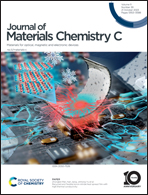Composite biomaterial for mimetic electric skin generated by conductive polymer/anion synergistic effect†
Abstract
Developing skin-like biomimetic materials with electromechanical and sensing sensitive properties, so-called E-skin, demonstrate the potential to serve as novel sensors for surface strain measurement. Thus, a versatile bionic E-skin that can perceive strain signals was fabricated based on an electronic/ionic-conductive polymer, named as the CNC@PPy/CS-Cit3−/PVA gel. Notably, the citrate ion (Cit3−) formed tridentate coordination with N-glucosamine units of chitosan (CS) to form an interpenetrating CS-Cit3− polymer network. More importantly, the coordinated Cit3− could enhance the mechanical properties of the gels and serve as movable “bridges” among the cellulose nanocrystals@polypyrrole (CNC@PPy) nanoparticles. The as-developed conductive gels exhibited consecutive conductive networks with high conductivity (up to 0.97 ± 0.05 S m−1). The sensitivity of this electronic/ionic-conductive skin could be divided into two separate regions at different strain ranges (the GF was 5.27 for strain under 0–2.8% and the GF was 1.24 for strain under 2.8–650%). Owing to the rapid response time (∼160 ms) and recovery time (∼100 ms), remarkable fatigue resistance, and biocompatibility, the E-skin-based sensor can precisely distinguish physiological signals and joint motions of the body. It was envisioned that the bionic E-skin would achieve broad applications as sensors in medical monitoring and implantable bioelectronics.



 Please wait while we load your content...
Please wait while we load your content...